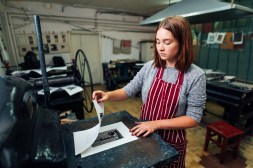Crafting an Engaging Artist Statement: A Step-by-Step Guide
As an artist, your artist statement is one of the most vital tools in your arsenal. This concise yet impactful document allows you to convey your artistic vision and intentions while helping you connect with your audience on a deeper level. However, writing an artist statement can be daunting for many artists. In this step-by-step guide, we will guide you through the process of crafting an engaging artist statement that effectively communicates your artistic practice.
Understanding the Purpose of an Artist Statement
Before diving into the process of writing an artist statement, it is crucial to understand its purpose. An artist statement serves as a window into your creative world, providing insight into the inspiration, motivation, and techniques behind your artwork. It helps viewers understand and appreciate your work by giving them a glimpse into your artistic journey.

To create a compelling artist statement, start by reflecting on questions like: What drives you as an artist? What themes or subjects do you explore in your work? How do you want viewers to interpret or engage with your art? By answering these questions honestly and thoughtfully, you will gain a clearer understanding of what should be included in your artist statement.
Finding Your Voice and Style
The key to crafting an engaging artist statement lies in finding your unique voice and style. Your artist statement should reflect who you are as an individual and what makes your work stand out from others in your field. To find this voice, take some time to explore different aspects of yourself and how they influence your art.
Consider delving into personal experiences, cultural influences, or philosophical beliefs that shape the way you create. These elements will help add depth and authenticity to your artist statement while allowing viewers to connect with you on a more personal level.
Additionally, pay attention to the language and tone used in other successful artist statements within your genre. While it is essential to maintain your individuality, studying these examples can provide helpful insights into how to effectively communicate your ideas and concepts.
Organizing Your Thoughts
Once you have a clear understanding of the purpose of your artist statement and have found your unique voice, it’s time to organize your thoughts. Start by creating an outline that highlights the key points you want to address in your statement.
Begin with an attention-grabbing opening sentence that encapsulates the essence of your artistic practice. Then, move on to discuss the themes, techniques, or concepts you explore in your work. Be concise yet descriptive, allowing readers to visualize and connect with your art through words.
Next, share insights into your creative process, discussing how you bring ideas to life and the materials or mediums you prefer. Include any significant influences or experiences that have shaped your artistic journey.
Finally, conclude with a strong closing statement that leaves a lasting impression on readers. This final paragraph should summarize the main points discussed while reinforcing the overall message of your artwork.
Refining and Editing
Once you have written a draft of your artist statement, take the time to refine and edit it. Read through it multiple times, checking for clarity, coherence, grammar errors, and spelling mistakes. Consider seeking feedback from trusted friends or mentors who can provide valuable insights and suggestions for improvement.
Remember that an artist statement is not set in stone; it can evolve as you grow as an artist. Regularly revisit and update it as necessary to ensure it accurately represents who you are as an artist at any given time.
In conclusion, crafting an engaging artist statement is a vital skill for artists looking to connect with their audience on a deeper level. By understanding its purpose, finding your voice and style, organizing your thoughts effectively, and refining through editing, you can create an artist statement that truly reflects who you are as an artist while captivating viewers with your artistic vision.
This text was generated using a large language model, and select text has been reviewed and moderated for purposes such as readability.


